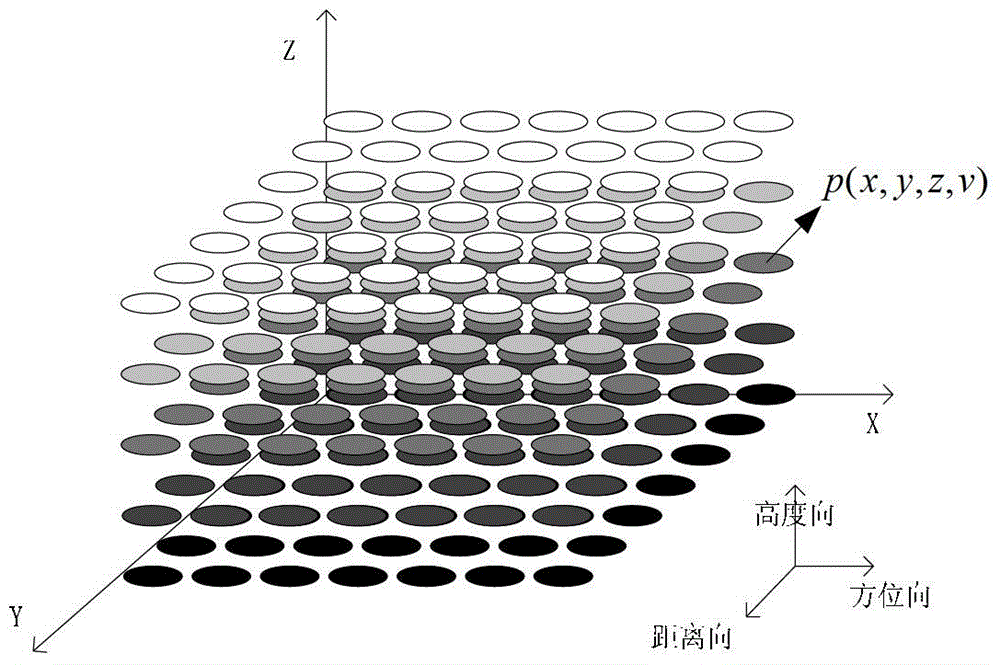3D imaging method of distributed SAR moving targets with non-uniform spatial configuration based on compressive sensing
A space configuration and compressed sensing technology, applied in the field of communication, can solve the problems of large data storage and transmission
- Summary
- Abstract
- Description
- Claims
- Application Information
AI Technical Summary
Problems solved by technology
Method used
Image
Examples
specific Embodiment approach 1
[0025] Specific implementation mode one: the following combination figure 1 Describe this embodiment, the non-uniform spatial configuration based on compressed sensing distributed SAR moving target three-dimensional imaging method described in this embodiment, the implementation steps of the method are:
[0026] Step 1. Establish a three-dimensional over-complete dictionary for moving objects: the over-complete dictionary refers to a given column vector containing M elements, which is expressed as a linear combination of Q generating vectors; wherein, M and Q are both positive Integer; when M=Q, and the Q vectors are independent of each other, then the column vector containing M elements can be uniquely represented, then the Q vectors are called a set of bases; and when Q>M When , these Q elements are called an over-complete dictionary;
[0027] Assuming that the three-dimensional position model and the velocity model of the ground scattering point are variables, and satisfy ...
specific Embodiment approach 2
[0040] Specific implementation mode two: the following combination figure 1 Describe this embodiment, this embodiment will further explain Embodiment 1, the specific implementation process of establishing a three-dimensional over-complete dictionary for moving objects described in step 1 described in this embodiment is:
[0041] Step A: First, the original echo signal r in the area covered by the SAR is sparsely represented, so that the signal can be represented as a combination of a series of base signals:
[0042] Introduce the discrete echo model:
[0043] S P ( t ^ , t m ) = rect [ t ^ - 2 R ( t m ...
specific Embodiment approach 3
[0071] Specific implementation mode three: the following combination figure 1 Describe this embodiment, this embodiment will further explain Embodiment 1, the specific implementation method of the overcomplete-based tracking moving target 3D imaging technology described in step 2 of this embodiment is:
[0072] The sparse representation of the echo signal r on the over-complete dictionary is obtained from step 1, and the three-dimensional over-complete dictionary Φ of the moving target has the restricted isometry property of the matrix, and the following noisy model is used to obtain the three-dimensional position information of the moving target with velocity information:
[0073] r=Φ(v)S+n=AXS+n (15)
[0074] Among them, A is the coefficient corresponding to each element in the three-dimensional over-complete dictionary Φ of the moving target; X is each element in the three-dimensional over-complete dictionary Φ of the moving target;
[0075] Let n represent Gaussian white...
PUM
 Login to View More
Login to View More Abstract
Description
Claims
Application Information
 Login to View More
Login to View More - R&D Engineer
- R&D Manager
- IP Professional
- Industry Leading Data Capabilities
- Powerful AI technology
- Patent DNA Extraction
Browse by: Latest US Patents, China's latest patents, Technical Efficacy Thesaurus, Application Domain, Technology Topic, Popular Technical Reports.
© 2024 PatSnap. All rights reserved.Legal|Privacy policy|Modern Slavery Act Transparency Statement|Sitemap|About US| Contact US: help@patsnap.com










